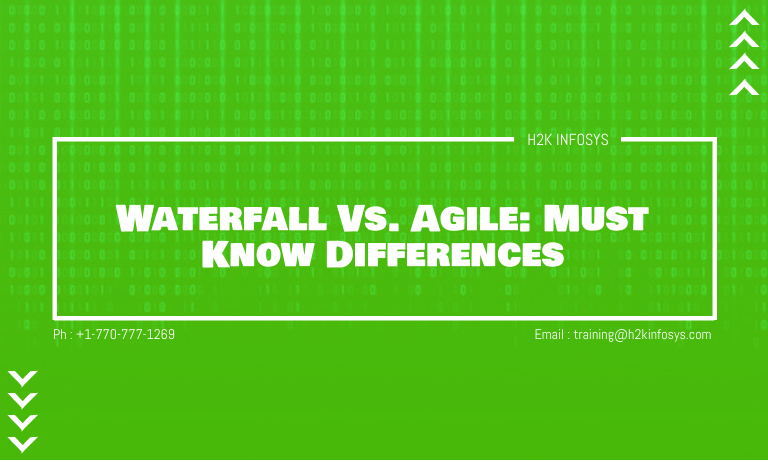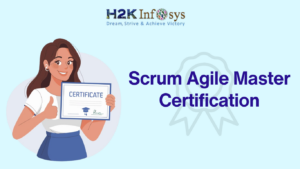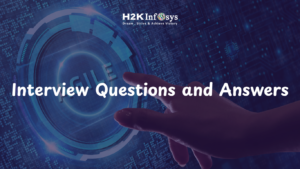Waterfall Methodology
The first process model to be implemented was the Waterfall Model. It is often referred to as a life cycle model that is linear-sequential. It is really easy to grasp and use. In a waterfall model, before the next step can begin, each phase must be completed and there is no overlap in the stages.
The earliest SDLC technique that was used for software development is the Waterfall model.
In a linear sequential flow, the waterfall model shows the software development process. This suggests that every step in the phase of development continues only if the prior stage is complete. The phases do not overlap in this waterfall model.
Agile methodology
An agile approach is a type of project management technique, commonly used for the development of software, where specifications and solutions emerge through the collective effort of self-organizing and cross-functional teams and their customers.
A set of concepts that prioritize adaptability and agility is the Agile approach. Agile seeks to have greater flexibility to evolving customer demands and also relies on allowing teams to deliver workable phases.
It was created as a response to the shortcomings of traditional methods of development such as the Waterfall approach and it is based on the Agile Manifesto’s values and principles.
Since the software is something that can be changed constantly, the software industry is a highly competitive market. This suggests that developers need to continually enhance and evolve their products to stay on top of the market, and the Waterfall strategy is not sufficient to sustain the pace of the market.
Key discrepancies in Agile and Waterfall
- Agile is a continual iteration of development and testing in the software development process whereas waterfall is a linear sequential life cycle method.
- The Agile approach is known for its flexibility while Waterfall is a formal methodology for software development.
- Agile methodology in comparison with the waterfall method follows an incremental approach while the waterfall model follows a sequential design process.
- Agile implements testing simultaneously with software development, while testing in the Waterfall technique comes after the “Build” process.
- Agile provides for improvements to the requirements for project developments while Waterfall is impossible to change requirements once project development begins.
Waterfall Model Advantages

- It’s one of the most manageable models. Each phase has its deliverables and a testing procedure according to its nature.
- It works well with smaller projects which have simplified, clear and understandable requirements.
- Earlier project completion
- The process and outcomes are well documented.
- Easily adaptable change team process
- This Project management approach for handling dependencies is helpful.
Agile Model Advantages
- It’s a focused customer process. So, it ensures that during every stage, the customer is continually involved.
- Agile teams are highly motivated and self-organized, so that development projects are likely to produce a better outcome.
- Agile software development technique ensures that development quality is preserved
- The process is based entirely on incremental progress. The client and team, therefore, know precisely what is fully functional and what is not. In the process of development, this reduces risk.
Constraints of Waterfall Model:
- For a large project, this is not an ideal model.
- It is a less effective method if the requirement is not clear at the beginning.
- Tracking back to make changes in the previous phases is very difficult.
- Once development is over, the testing process starts. Therefore, bugs are highly likely to be found later in development, where they are costly to fix.
Constraints of Agile Model
- For small development projects, it is not a useful technique.
- It requires an expert in the meeting to make significant decisions.
- Compared to other development methodologies, the cost of implementing an agile method is significantly greater.
- If the project manager is not clear what result he or she expects, the project can easily go off track.
Difference between Agile and Waterfall Model:
| Agile | Waterfall |
| It divides the lifecycle of project development into sprints. | The process of software development is split into different phases. |
| This follows an incremental plan. | The technique of Waterfall is a sequence method of design. |
| The agile technique is valued for its flexibility. | The waterfall model is a structured methodology for software development such that it is very linear much of the time. |
| Agile can be seen as a collection of various projects. | The development of software as one single project is to be completed. |
| Agile is quite a flexible methodology that enables adjustments to be made in the requirements for project implementation even though the initial preparation has been completed. | When project planning begins, there is no scope to adjust the requirements. |
| The agile technique, using an iterative development strategy due to this planning, development, prototyping, and other stages of software development may occur more than once. | Once in the Waterfall model, all stages of project development, such as planning, development, testing, etc., are achieved. |
| After every sprint, the test plan is reviewed. | During the test process, the test strategy is rarely discussed. |
| Agile development is a method that is meant to modify and refine the requirements. | The approach is suitable for projects with complex requirements and improvements which are not planned at all. |
| Testing is done in accordance with software development in Agile methodology. | In this approach, the “Testing” process follows the “Build” phase. |
| Agile offers a product viewpoint in which the software product meets user demands and adjusts to meet customer requirements. | This model reflects a project mentality and focuses solely on the accomplishment of the project. |
| The agile technique works incredibly well for Resources & Assets or non-fixed funding. In fixed-price scenarios, stress can increase. | Reduces risk by obtaining a risk arrangement at the start of the phase in firm-fixed-price contracts. |
| Prefers limited but committed teams with a high level of teamwork and synchronization. | Coordination/synchronization of teams is very limited. |
| During a project, the product owner with the team prepares requirements almost every day. | Before the beginning of the project, business research prepares specifications. |
| The test team will engage in the change of requirements without any problems. | Initiating any change in requirements is difficult for the test to initiate. |
| Project specifications can be updated at any time during the SDLC process. | The approach of waterfall software development needs to be implemented in a detailed description. |
| Agile offers a product viewpoint in which the software product meets user demands and adjusts to meet customer requirements. | The approach is often simple in the waterfall method; thus, the project manager plays an important role during any phase of SDLC. |




























